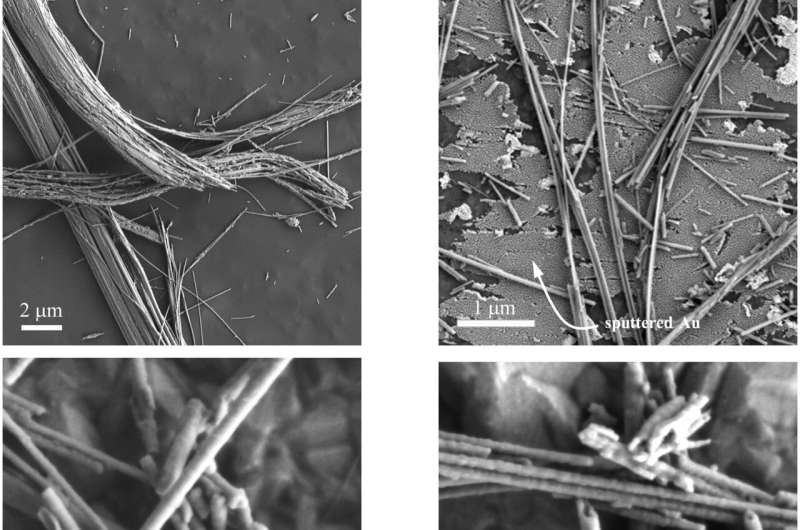This article has been reviewed according to Science X's editorial process and policies. Editors have highlighted the following attributes while ensuring the content's credibility:
fact-checked
peer-reviewed publication
trusted source
proofread
Researchers identify a cheaper, more convenient method to detect asbestos

For decades, a laboratory procedure known as transmission electron microscopy (TEM) has been used to test for asbestos in samples taken at construction sites.
In 1989, the U.S. Environmental Protection Agency (EPA) required most schools undergoing asbestos abatement to use TEM to test for the presence of asbestos fibers in air samples before reopening. Several states require or recommend using TEM for testing as part of asbestos removal in commercial buildings.
But TEM must be carried out in a specialized lab by highly trained staff and can be expensive. Another approach, phase contrast microscopy, is easier and cheaper but less precise.
Now, researchers at the National Institute of Standards and Technology (NIST) have determined that a third option, scanning electron microscopy (SEM), can achieve results roughly comparable to TEM. SEM is a "viable alternative to the current regulatory methods for asbestos identification and classification," the NIST researchers Jason Holm and Elisabeth Mansfield wrote in a new paper published in Analytical Methods.
Since SEM is, in many cases, cheaper and more convenient than TEM, the finding could potentially speed up and reduce the expense of asbestos remediation in the United States, which costs an estimated $3 billion every year.
Asbestos is a naturally occurring mineral whose fibers were used for insulation, weather- and fire-proofing and reinforcing building materials. Its use began declining in the 1970s as researchers became aware of its health risks, including its link to cancer. In March, the EPA banned the last form of asbestos still in use.
As their names suggest, both TEM and SEM are types of electron microscopy. In both methods, technicians focus electron beams on a microscopic amount of material. Electrons interact with the material to produce highly detailed information on the material's composition, structure and shape.
With TEM, the electrons pass through the sample, whereas with conventional SEM, they are reflected off the surface. This enables TEM to produce more detailed images and probe the surface's interior. TEM also offers much better spatial resolution—the ability to distinguish between objects very close together—than SEM.
But in recent years, SEM manufacturers have improved the technology's imaging power and other capabilities. Several companies now produce tabletop SEMs, making it possible to use the technology in the field, while TEM must still be done in a lab. Holm said training to use and operate SEM equipment can be completed in several months, while "expertise in TEM can take years to establish."
"There are some capabilities TEM has which SEM doesn't, but we think SEM is good enough" for use in asbestos abatement, said Holm.
To test SEM on asbestos, Holm and Mansfield used NIST Standard Reference Material (SRM) 1866, a sample of asbestos fibers the agency produces for labs to benchmark their equipment and testing procedures. The SRM comes with extensive data characterizing the properties of the material.
Using SEM, the researchers analyzed SRM 1866. Their results closely agreed with those listed in the SRM's documentation, indicating the method's accuracy.
Holm and Mansfield summarized SEM's potential advantages by writing that it could result in "lower equipment cost, less stringent operator training requirements, increased sample throughput and greater field of view compared to TEM."
More information: Jason D. Holm et al, Transmission electron imaging and diffraction of asbestos fibers in a scanning electron microscope, Analytical Methods (2024). DOI: 10.1039/D4AY00555D
Journal information: Analytical Methods
Provided by National Institute of Standards and Technology
This story is republished courtesy of NIST. Read the original story here.




















